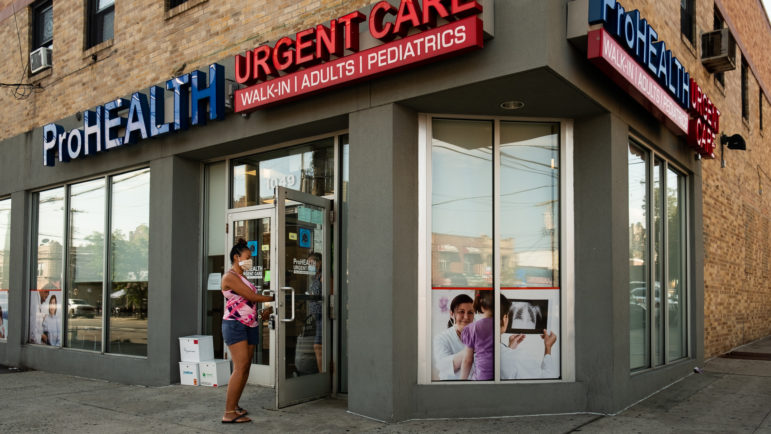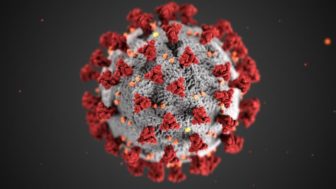
Adi Talwar
Bronx Park Urgent Medical Care on Bronxdale Avenue in the Bronx is one of the many sites in the city providing COVID-19 testing services.Last week, Jay Varma, a senior adviser for the city’s Department of Health, recommended New Yorkers get tested for COVID-19 at least monthly.
“The rule of thumb that I follow myself and I encourage others to do is to make sure you’re tested at least once every month,” Varma told reporters at a press briefing. “About once a month is practical.”
The advice was a sea change from the city’s approach earlier on, during the peak of the pandemic this spring, when the Health Department urged providers to only test patients in need of hospitalization, an attempt to conserve protective equipment and other supplies at the time. Today, the city says it has the capacity to test 50,000 New Yorkers a day, and the mayor’s office has been urging residents to seek out those tests, hosting a “Get Tested Day of Action” Tuesday as part of its efforts to contain the pandemic.
But some have questioned whether the city’s testing-for-all strategy is the right one, especially as school buildings prepare to reopen in the coming weeks, citing ongoing delays for some New Yorkers in receiving results. While the city says the median turnaround time for coronavirus results at its Health + Hospital testing sites is two days, many at those and other locations have reported waiting as long as weeks to get theirs.
On Saturday, at a new testing site in Sunset Park, Brooklyn—where the city has ramped up testing efforts to combat a recent uptick in positive cases—workers told those getting tested that they should expect their results in three to five business days, what health experts say surpasses the threshold of usefulness in containing the virus.
“If it’s more than two days, it’s not very useful to control disease,” says Cyrus Shahpar, director of a team to prevent epidemics at Resolve to Save Lives, a global health initiative led by former city Health Commissioner Tom Frieden. “From a public health perspective, 900,000 tests that come back in a week are much less [useful] than 500,000 tests that you get back in one or two days.”
Councilman Mark Levine, who heads the City Council’s health committee, has been calling for the city to take a more strategic approach with its testing resources. If all New Yorkers actually took Varma’s advice to get a COVID-19 test once a month, that would shake out to about 200,000 people flooding the city’s testing sites each day, he says—far beyond New York’s current capacity and about a quarter of the current national capacity.
“Our measure of success can’t just be how many people are getting tested, it has to be, are the right people getting tested?” Levine says.
He says that until testing capacity improves, priority could be given to the most vulnerable and those who meet certain risk factors, such as people with public-facing jobs. “I worry about, with the opening of schools, whether or not there will be enough rapid testing to test all the staff before we get open.”
Other states have made similar moves in backtracking their testing strategy to address lab result delays. In July, as COVID-19 cases in the state climbed, California moved away from offering tests to anyone who sought one to a “tiered system” prioritizing people with symptoms, those who’ve been exposed to the virus or who meet other high-risk criteria.
Shahpar says such testing strategies could include prioritizing people such as those who live and work in facilities like nursing homes, where outbreaks have proven to be especially dangerous.
“If there’s one case in a nursing home, you’ve got to test everybody in the nursing home, staff and residents, as soon as possible,” he says.
A spokesman for the city’s Health Department says it currently provides rapid COVID-19 testing—with results in 24 hours or less—for critically-ill people, and also plans to prioritize test results for teachers in the lead up to the new school year.
Levine says other low-hanging fruit would be for the city’s urgent care facilities to stop offering coronavirus testing to all patients, regardless of if they have symptoms or even initially requested a test.
“If you walk into a CityMD right now for any purpose, for a sprained ankle, for a rash for anything, you’re going to get offered a COVID test,” he says. “That’s clogging up lab resources.”
The city says it’s made a number of efforts to improve testing capacity and turnaround times, including diversifying its lab partners and encouraging those labs to adopt pooled testing methods. The Health Department is also in the process of rolling out new testing sites at nine of its sexual health clinics, where results will be ready in 24 hours or less (three of those sites are already up and running, Levine tweeted Tuesday).
But local capacity is largely hampered by what’s happening on the national level, as COVID-19 cases continue to surge in states across the country and demand for tests outstrips supply.
“Even a surge as far away as Arizona is going to potentially create backlogs for us here in New York City,” says Levine.
Public health experts have been calling on the federal government to organize a nationwide testing strategy: At the moment, states and local jurisdictions “are kind of on their own in terms of who to test,” resulting in uneven testing approaches across the country, Shahpar says.
A plan released last month by the Rockefeller Foundation says that to successfully manage the pandemic, the country needs to be able to administer at least 25 million tests per week, with a 48-hour standardized turnaround time, which it says would require $75 billion in immediate federal funding. The Centers for Disease Control and Prevention reported that just more than 2 million COVID-19 tests were conducted nationwide during the week of Aug. 2-8.
“In order to get to a better place this stuff needs to be fixed,” Shahpar says. “And really, it’s going to require this kind of cohesive strategy.”










One thought on “With Some Results Still Backlogged, Should NYC Rethink its Testing-for-All COVID Strategy?”
The experienced (actual) turnaround time for tests at ALL testing sites should be a “Daily Reportable Metric”. It is such an important metric (for many reasons) it is unclear why this is not as important a metric as many others in the past in the Public Health field.
It could also be helpful in the design and allocation of testing sites for a specific community.